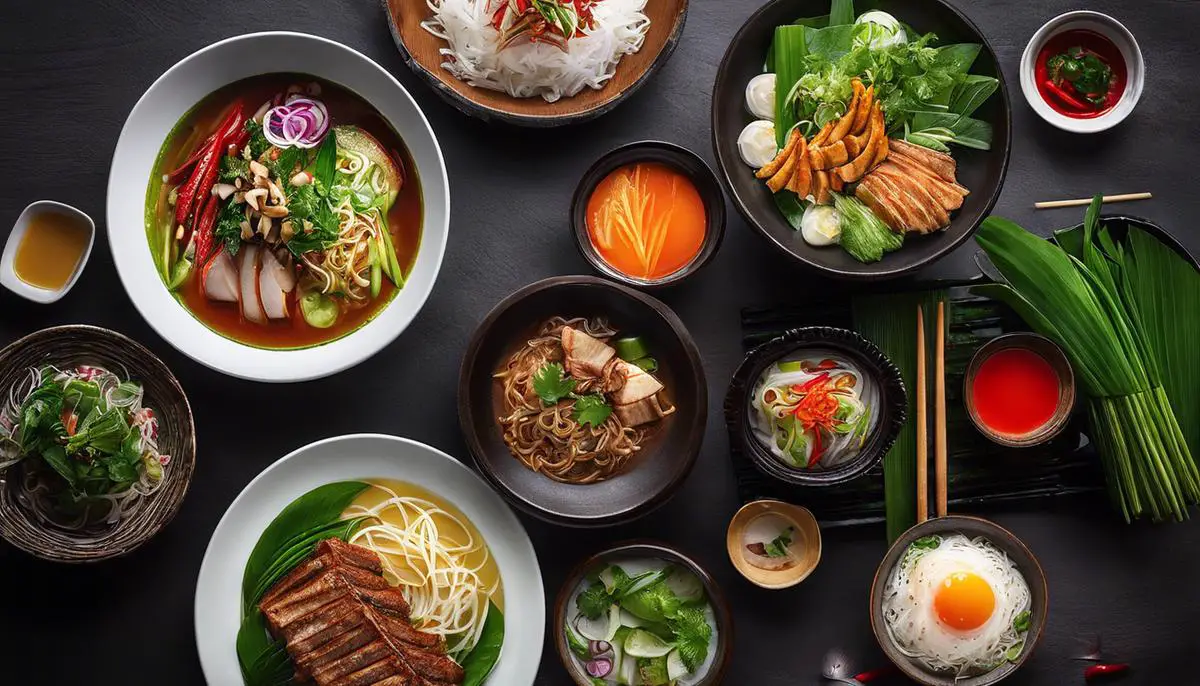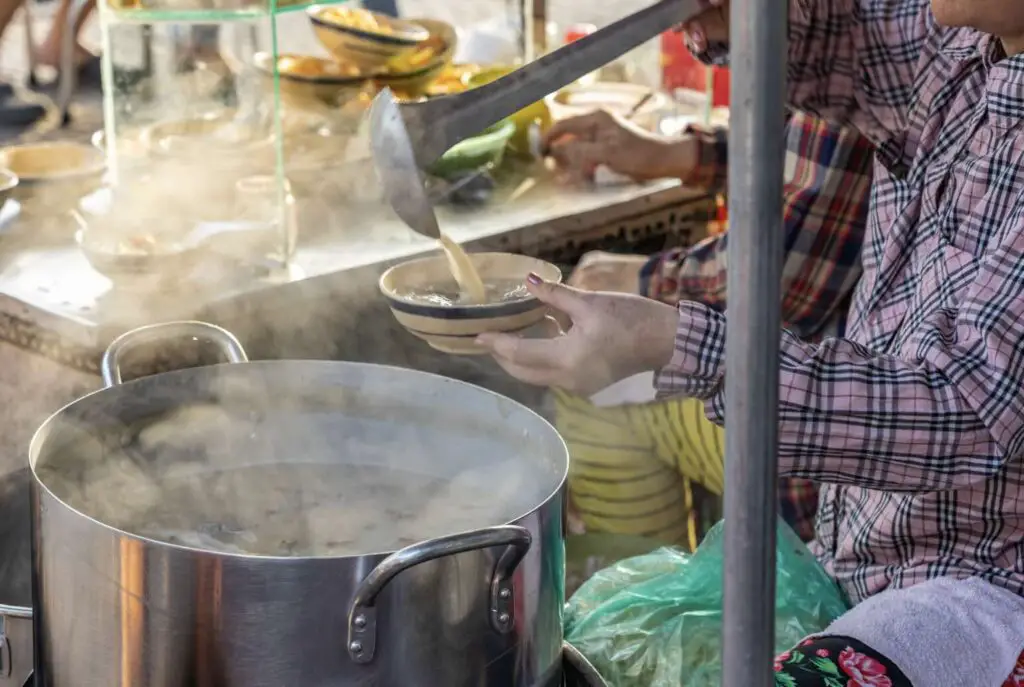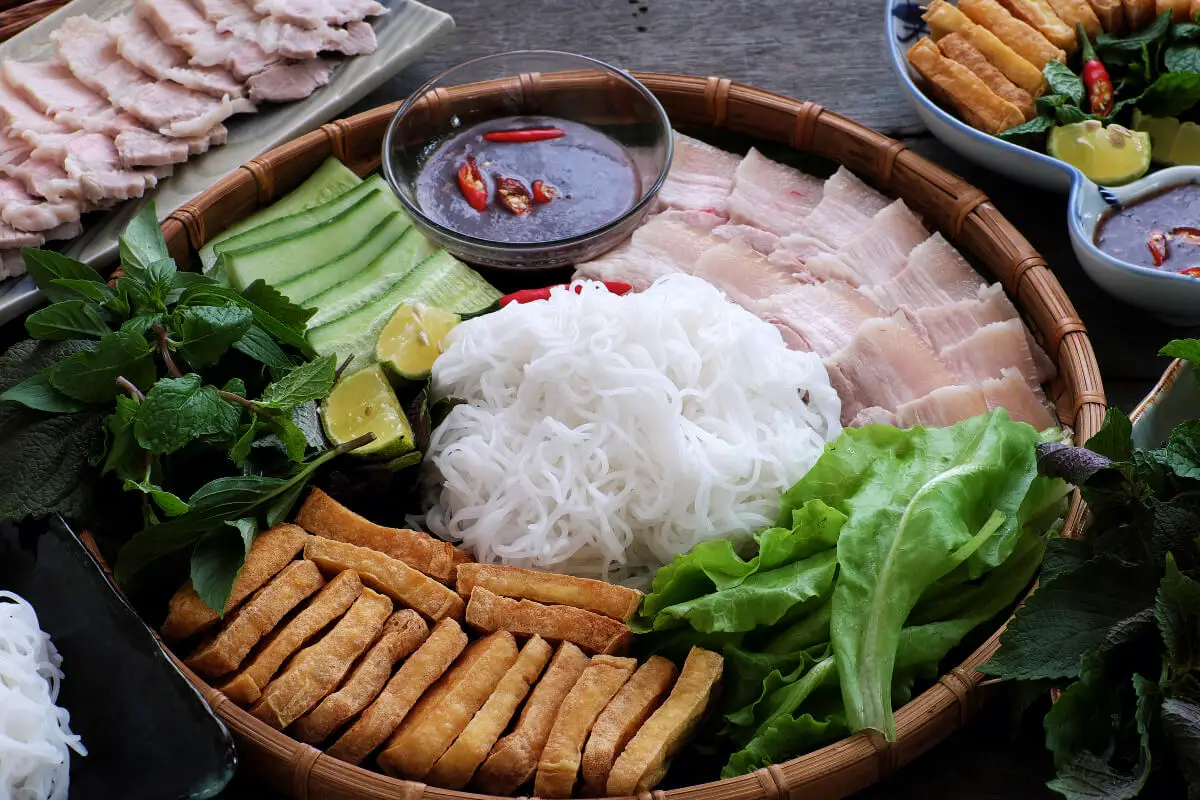Culture is a magnificent tapestry woven with threads of tradition, cuisine, art, history, and customs. Few places showcase this as vividly as Vietnam, a country steeped in thousands of years of history and rich culture.
This journey into Vietnamese culture is about understanding its tantalizing cuisine or deeply ingrained societal norms and exploring the nation’s soul. We step into art and society, feasts and festivals, traditional customs, and the force of history that has chiseled and shaped the nation’s character to appreciate the depth and diversity of this vibrant culture.
Table of Contents
- Feasting on the Vietnamese Cuisine
- Art and the Vietnamese Society
- Traditions and Celebrations in Vietnam
- Influence of History on Vietnamese Culture
- Understanding Vietnam’s Social Etiquettes
- Related Questions
Feasting on the Vietnamese Cuisine
A Culinary Extravaganza
Strap in gastronomes because we’re about to embark on a culinary journey through the enchanting, diverse world of Vietnamese cuisine. This remarkably unique fare isn’t just about satisfying those hunger pangs; instead, it’s an artful blend of flavors representing the spirit and culture of Vietnam.
The Harmony of Five Fundamental Tastes
Just as a maestro conducts an orchestra to create mellifluous melodies, Vietnamese cuisine combines five fundamental tastes – sweet, salty, bitter, sour, and umami – in perfect harmony. Every dish is meticulously prepared to strike a balance between these tastes, creating a flavor explosion that’s truly memorable and utterly addictive.
Think tangy lime, aromatic cilantro, hearty fish sauce, and fiery chili peppers dancing together in a delicious medley on your palate.
The Enrichment of Indigenous Ingredients
Drawing inspiration from the region’s natural abundance, Vietnamese cuisine makes prodigious use of fresh fruits, vegetables, herbs, and seafood.
The country’s diverse geography, from fertile plains to highlands and coastline, gives chefs access to a vast array of home-grown produce and locally caught seafood. This dependency on seasonality gives Vietnamese cuisine its characteristic vibrancy and freshness.
Health is Wealth
The health aspect of Vietnamese cuisine is worth mentioning; it is arguably one of the healthiest in the world. There’s a heavy emphasis on using fresh ingredients, minimal dairy, and lean proteins, which promotes a healthy lifestyle. Herbs are not just used as garnish; they dictate the flavors and are critical players in every meal. And who said eating healthy must be boring?
Varied Regional Deliverance
One can’t simply put all Vietnamese food into a single category, as different regions offer their specialties with distinctive flavors and cooking techniques. Hanoi, in the north, is known for its subtle flavors in dishes like ‘phở,’ while southern Ho Chi Minh City offers more robust and dynamic meals such as ‘bún thịt nướng.’ Essentially, a culinary discovery lurks in every corner of Vietnam, waiting to seduce food lovers.
Vietnamese Street Food: A Culture Unto Itself
Vietnamese street food alone could merit a league, brimming with simple yet divinely flavorful bites. You’ll find markets and roadside stalls hemming and hawing with aroma-rich soups, succulent grilled meats, and crisp rice pancakes that offer an immersive culinary experience.
Vietnamese cuisine is a colorful tapestry of taste sensations, deftly spun from various influences, ingredients, and techniques. This cuisine embodies the country’s rich history, regional differences, and philosophy of balance, a testament to Vietnam’s people and innovative spirit.
So why not let your taste buds wander and embark on an exciting food adventure? After all, life is too short not to experience the magic of Vietnamese cuisine!

Art and the Vietnamese Society
Immerging into the Vibrant Canvas of Vietnamese Art
Vietnam, a country with a history as rich as its cuisine, proudly presents a resilient, reverberating culture that bears the testament of time. A crucial part of this culture is its profound and significant spectrum of art forms that resonate with the heartbeats of its people. The vibrancy of Vietnamese art is a kaleidoscope of colors that tell the country’s epic tales, depicting the true spirit of its land.
Travelers traversing Vietnam’s rural and urban landscapes will quickly note the enduring influence of art on Vietnamese life; it’s their breath, beat, and soul. The enthralling beauty of Vietnamese arts, from bụi đời street style to classical lacquer paintings, highlights the incredible diversity and richness of Vietnam’s culture.
The Power of Vietnamese Lacquer Art
Historically, Vietnamese art has been heavily influenced by Chinese styles, but its uniqueness lies in the prominence of lacquer art. Lacquerware is a centuries-old tradition in Vietnam, admired for its meticulous process and radiant finish. Capturing the nation’s collective memory and spirit, these shimmering pieces of exquisite artistry triumph over time, constantly evolving while maintaining a bold projection of the authentic Vietnamese character.
Like painters in oils or watercolor, lacquer artists use their skills to create pictorial effects that speak to the Vietnamese historical narrative and their everyday lifestyle. A lacquer painting requires persistence, patience, and meticulous attention to detail, reinforcing the Vietnamese principle of investing dedicated, heartfelt effort into their work, a quintessential part of their culture.
The Spirit of Vietnamese Silk Painting
With elegant brush strokes on lustrous Vietnamese silk, silk painting graciously retains the country’s artistic heritage. It’s where Asian and French styles harmoniously collide to create a sense of tranquility and introspection. The sheer, iridescent material interacts with the light, transforming each piece into a living landscape reflecting their natural world – a treasured element of Vietnamese culture.
The Folk Art of the Common Persons
From the North’s Đông Hồ painting to the South’s intricate Khmer shadow puppetry, Vietnam’s folk art offers a glimpse into everyday men’s and women’s lives. It’s the art of the rice farmers, the fishmongers, and the fruit vendors; the art that adorns streets and festivals; the cultural mirror that reflects the populace’s dreams, aspirations, fears, and laughter.
Folk art perpetuates ancestral stories, age-old traditions, and Vietnamese people’s humble & vibrant lifestyle.
The Sea of Contemporary Vietnamese Art
Contemporary Vietnamese art serves as a fluctuating reflection of the country’s modern narrative. A captivating fusion of the East and the West, it illustrates the nation’s resilience and adaptability in the face of change.
Galleries across Vietnam showcase various Vietnamese artists, painting a visual commentary on political, social, and environmental issues, confirming the critical role of art as a universal language and an emotional catalyst for conversation about change.
Looking at Vietnam through the lens of its art opens the door to its soul. Whether lacquerware, silk painting, folk art, or contemporary work, they all narrate the Vietnamese story of courage, resilience, peace, and progress, becoming a significant pillar of their vibrant culture.
The immersive experience of the Vietnamese art scene is, undoubtedly, a cultural exploration that should not be missed on any adventurer’s itinerary.

Traditions and Celebrations in Vietnam
Artistic Traditions Giving Voice to the Vietnamese Spirit
One could travel through the beautiful landscapes of Vietnam and miss the essence of Vietnamese culture if one doesn’t take a moment to appreciate its deep-rooted artistic heritage.
Art has always been prominent in Vietnamese society, telling tales of bravery and compromise, hope and resilience, and mirroring the nation’s multifaceted cultural ethos.
Undeniably, an unmistakable tint of Chinese influence is stained on the canvas of Vietnamese art history. The neighboring colossus profoundly impacted the creation and evolution of Vietnamese artistic styles.
Yet, Vietnam’s art managed to retain a unique character, deviating from depictions of mythical beings and abstract philosophies toward more earthy, pure representations of everyday life.
Adding to the artistic tapestry of Vietnam is lacquerware, an endeavor of patience and precision, anticipated to have originated around 3,000 years ago. The process of creating these intricate artworks is meticulous. It involves multiple rounds of adding and then sanding off multiple layers of lacquer on a wooden base.
The finished products are deeply symbolic, telling stories of rural Vietnamese life, family values, and local folklore.
Another art form steeped in Vietnamese heritage is silk painting, which began in the 20th century. Intertwining Vietnamese vision with French techniques, these paintings project a serene richness that bridges the elegance of Asia with the tranquility of European artistry.
The resultant pieces capture Vietnam’s scenic beauty, from its ubiquitous lotus ponds to enchanting mountains.
Meanwhile, folk art in Vietnam can’t be missed. The Đông Hồ painting style originates from the Red River Delta and is simple yet profound. These artworks employ wooden blocks to print images on special paper, often reflecting everyday Vietnamese life’s pure, simple, and joyous spirit.
Adding to this beautiful diversity, the shadow puppetry of southern Vietnam’s Khmer ethnic group is another traditional art form worth admiring. These intricate puppets of leather punctuate storytelling performances with haunting beauty, usually accompanied by a traditional orchestra.
And let’s not forget the role of contemporary art, which is witnessing a renaissance, redefining narratives and exploring modern issues through the lens of emerging talents. Vibrant and edgy, these pieces respond to a different kind of Vietnam that is not shy to voice its opinions and concerns.
As told through its art, the story of Vietnam is a story of courage, resilience, peace, and progress. Vietnam’s art captures its people’s essence – their struggles, triumphs, dreams, and hopes.
It is as diverse as the country itself. So, allow yourself to be molded by its beautiful culture, rich history, art, and people. Traveling to Vietnam immerses oneself in its landscapes and shares communion with its artistic spirit.

Influence of History on Vietnamese Culture
Artful Heritage: How Vietnam’s Vibrant Past Shapes its Contemporary Culture
Immersing oneself in the local culture upon arrival in Vietnam means immediately feeling the embrace of hundreds of years of history, manifested particularly in the country’s artistry. Ancient influences and modern advancements that froth together have developed a unique Vietnamese cultural identity that is impossible to ignore.
Chinese influence has been blowing through Vietnam for over a millennium. Beginning in the first century BC and continuing until the 10th AD, their cultural imprints, particularly in portraying mythical creatures and Buddhist motifs, are deeply woven into the tapestry of Vietnamese art.
Yet, Vietnam is not just a silhouette of China. It has carefully curated its artistic identity by fusing imported styles with indigenous creativity.
A glimmering example of this lies in the art of lacquerware. Originated by the indigenous people of northern Vietnam, this meticulous process involves the application of treated resin from the lacquer tree, coupled with layers of varnished gilding, resulting in luminous and enduring art.
Within these radiant lacquer creations often lie incredible tales. The impressive images and intricate designs capture Vietnam’s rich legends, honoring its past and nourishing its present culture through storytelling.
Moving from robust and radiant to delicate and serene, Vietnamese silk painting emerges as another local art form to be revered. Combining Asian symbolism with French impressionist techniques marked a significant turning point in Vietnam’s artistic evolution. The silk canvas whispers tales of tranquility, elegance, and graceful Vietnamese life with each stroke.
A stroll down the rustic lanes of the country may lead to an encounter with Vietnam’s folk art forms, such as Đông Hồ painting and Khmer shadow puppetry. These are authentic reflections of daily life where every stroke and every silhouette carries a storyline intimately tied to the local life and traditions.
Then, as we witness today, the canvas of Vietnam artistry did not remain static. The torrent of socio-political change ushered in a flood of contemporary artists eager to address modern narratives. They explore new landscapes of freedom, identity, and the gap between urban and rural lives through their lenses.
Indeed, Vietnam’s art echoes the country’s identity: enduring, diverse, and resilient. It harmoniously merges the memory of significant historical events with day-to-day life vibrancy. Despite periods of intense struggle, today’s Vietnam radiates with vigorous valor, unwavering resilience, serene peace, and inspiring progress.
Next time you find yourself wandering through Vietnam, pausing to marvel at a piece of lacquerware, admire a silk painting, or lose yourself in a puppet show, you’ll be glimpsing into the heart of a nation defined by its inspiring artistic spirit.

Understanding Vietnam’s Social Etiquettes
Commencing one’s cultural journey in Vietnam, observing how time-honored social norms and etiquettes are woven into day-to-day living is fascinating. Dipped in tradition and infused with an indomitable spirit, it’s an enchanting portrait of collective harmony and individual respect.
One of the first social norms observed in Vietnam is modesty in demeanor and dress. Vietnamese culture leans towards conservatism, valuing conscientiousness and etiquette in actions and attire. Avoid flashy or revealing clothing; instead, favor attire that respects local customs and the tropical climate.
Hierarchy forms a significant part of Vietnamese etiquette, mirroring the nation’s Confucian influences. Always be aware of the presence of elders. Offering a respectful bow and avoiding direct eye contact is not deemed as evading; instead, acknowledging their authority and wisdom.
Sit lower than them in a gathering and wait for them to start eating or drinking first. Traditions often serve as unwritten rules, and respecting them accentuates an understanding of Vietnamese culture.
Amicable gestures form the backbone of Vietnamese etiquette. Shaking hands, often with both hands, is a norm, irrespective of gender. Embrace the local greeting etiquette to make connections and build rapport with local people. And remember, exchanging business cards necessitates using both hands to show respect.
On the streets of Vietnam, motorbikes rule! The roads are a mix of organized chaos filled with motorbikes, bicycles, vendors, pedestrians, and even livestock. Crossing the street is an unusual dance, mastered with patience, a steady pace, and a little bravery. So, fear not; step up, walk calmly, and watch how traffic navigates around you!
Another cornerstone of Vietnamese culture is their shared love for food. Always accepting an offered meal signifies respect for the host and acceptance of their hospitality. And don’t forget, using chopsticks correctly ensures a superb gastronomic experience!
Vietnamese people place a lot of importance on the concept of ‘face,’ a blend of reputation, dignity, and honor. Any attempt at public criticism or humiliation can result in the loss of face and damage relationships. Face-saving gestures cherish the underlying respect for individual identity and social status in Vietnamese society.
As you navigate Vietnamese life and culture, remember that the essence of travel lies in learning and embracing the unfamiliar. Enjoy the symphony of sounds, the generous smiles, the delectable cuisine, and the rich customs.
Even better, carry these lessons onwards, embodying the ethos of Vietnam: “When drinking water, remember its source,” a proverb beautifully captures their gratitude and humility.
Ultimately, it’s not just about exploring a new culture — it’s about becoming a part of that culture. Welcome to Vietnam, fellow nomads!
In Vietnamese: Chào mừng các bạn đến với Việt Nam!
As we saw, the tapestry of Vietnamese culture is not only wide-ranging but also rich in depth and intricacy. The key threads – the cuisine, art, traditions, influence of history, and societal etiquette – together weave an image of a culture steeped in history yet dynamically evolving.
Yet, the people of Vietnam, with their resilience, adaptability, and steadfast spirit, truly represent and preserve this cultural treasure. They embody the lessons from their past the vibrancy of their present, and hold an unwavering hope for their future, thereby ensuring that the mesmerizing cultural tapestry that is Vietnam continues to thrive and captivate the world.
If you’re seeking efficient ways to navigate Vietnam, we suggest referring to the Book a Way website. This platform offers valuable insights and clear guidance on traveling between various locations within the country. To learn more about their services, click on the link provided below.
At A Bus On A Dusty Road, we discuss history, travel, life, sailing, and ex-pat living. We are all about “Living Life As A Global Citizen.” We explore social, cultural, and economic issues and travel.
We would love to have you be part of our community. Sign up for our newsletter to keep up-to-date by clicking here. If you have any questions, you can contact me, Anita, by clicking here.
Listen to our Podcast called Dusty Roads. You can find it on all major podcast platforms. Try out listening to one of our podcasts by clicking here.
Subscribe to our A Bus On A Dusty Road YouTube Channel filled with great videos and information.
Related Questions
What Makes Vietnamese Food So Delicious?
Vietnamese food is delicious and is gaining in popularity—one of the reasons is that good Vietnamese food uses only fresh herbs and ingredients. Vietnamese food also touches all of our five senses. The Vietnamese are masters at using sweet and sour tastes for their food.
You can discover more by reading What Makes Vietnamese Food So Delicious? by clicking here.
The Vietnamese Bun Cha Food Dish, All You Need To Know
One of North Vietnam’s most popular food dishes is bun cha. When you travel in North Vietnam, you will see signs everywhere advertising the sale of this famous dish called Bún Chả.
You can learn more by reading The Vietnamese Bun Cha Food Dish, All You Need To Know by clicking here.
Vietnamese Culture: Deep Dive Into Vietnam’s Culture
There’s so much we can learn from Vietnamese traditions and values. With its breathtaking landscapes, varied ecosystems, and vibrant cities, Vietnam is not merely a spot on a traveler’s itinerary. It’s a country rich in enduring traditions, values, and customs, offering a fascinating glimpse into Asia’s vast mosaic of cultures. Let’s delve deeper into why the Vietnamese culture is so captivating and rewarding to be immersed in.
By clicking here, you can discover Vietnamese Culture: Deep Dive Into Vietnam’s Culture.


